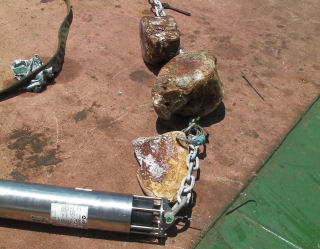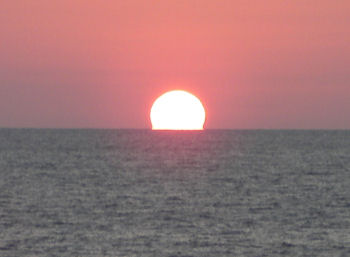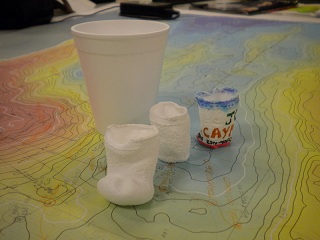Monday 19th April
The end of our time here in the Cayman Trough is fast approaching - but to round off our expedition, we have discovered a second set of deep-sea vents! Our recent Autosub6000 missions, and surveys with the CTD probe, detected chemical fingerprints of deep-sea vents above Mount Dent. Once we had detailed maps of the seafloor, which showed a small mound where we found the strongest signals, we sent down HyBIS to take a look.
Flying slowly across the seabed at a depth of 2300 metres on Mount Dent, we started to climb the mound seen on our map, and saw 'shimmering water' - hot water that looks like the haze rising from a road on a hot day - and then a lush abundance of marine life. The vents look different here - all on a pyramid-like peak rather than separate slender chimneys, and with less visible black smoke, which made them harder to find - but they are no less spectacular.
The challenge now is to compare the chemistry, geology and biology of this second set of vents with the much deeper ones that we found earlier. We need to understand how the sites may be related, and whether their populations of marine life are linked. HyBIS managed to collect some samples of rocks and animals that will help us answer those questions.
Unfortunately we can't post photos of the second set of vents just yet, as it is impossible to film or photograph them without revealing the marine life around them - and that information has to be published in a scientific journal, and checked by other scientists, before we can make it public. It is frustrating, but those are the rules in science, which we have to follow! Rest assured that as soon as we can share the full details, we'll do so right here.
After exploring the second vent site, we moved back to the first set of vents in deeper water, to deploy our second mooring. Like the other mooring that we're leaving behind until our next expedition, this consists of more than a kilometre of cable floating above the seafloor, carrying instruments to measure the currents and physical properties of the water over time. And this one is also carrying the remainder of our whalebones, to see what colonises them in the Cayman Trough. The photo below shows the whalebones attached to the bottom of the mooring, just above the 'acoustic release' device, which we will use to send the mooring back to the surface when we return to the area.

Today we also caught up with Kate, who leads the physical oceanography component of our research programme, to hear her thoughts on the progress of the expedition. Kate said: 'Everything has gone so well; normally equipment breaks because of the extreme stress it is under, but we have had so few things go wrong. Everything we planned to do we have completed, and so much more. Finding two vent sites has been incredible. We could not have achieved this without the support of the crew, who have been so involved with our discoveries.'
Kate and PhD student Sarah have been using a variety of instruments to measure the physical properties of the deep water in the Cayman Trough - its currents, salinity, and temperature - from which they will be able to deduce the where the water comes from, and how it fits into the wider ocean circulation of the region. Their primary tools for this work are the CTD probe and the sensors carried by Autosub6000. The instruments that we are leaving behind for at least a year on the moorings will also help to complete their records.
Although Kate's work does not directly relate to the search for deep-sea vents, understandig the circulation in the Cayman Trough will also help the marine biologists to understand where the inhabitants of the vents may have come from, and how easy it is for them to make the journey between the two sets of vents that we have now discovered.
A conversation with Rolf, who joined this expedition from the University of Bergen in Norway, shows the international collaboration in this field of science. Rolf has a track record in 'hunting' for hydrothermal vents, having led the team that discovered the world's northernmost black smokers in the Arctic. Rolf has been able to compare his discoveries on a slow-spreading ridge in the Arctic with those on the slow-spreading ridge here, and also see Autosub6000 and HyBIS in action finding new vent sites.

Our last task of the day, after a spectacular sunset, is another survey with the CTD probe to collect more data for Kate and Sarah. And as this is the last CTD deployment of the expedition, it is also the last chance for shrinking polystyrene coffee cups as keepsakes. Coffee cups that make the round trip into the ocean depths attached to the CTD get squashed by the pressure to roughly thimble-size, as the picture below shows.



